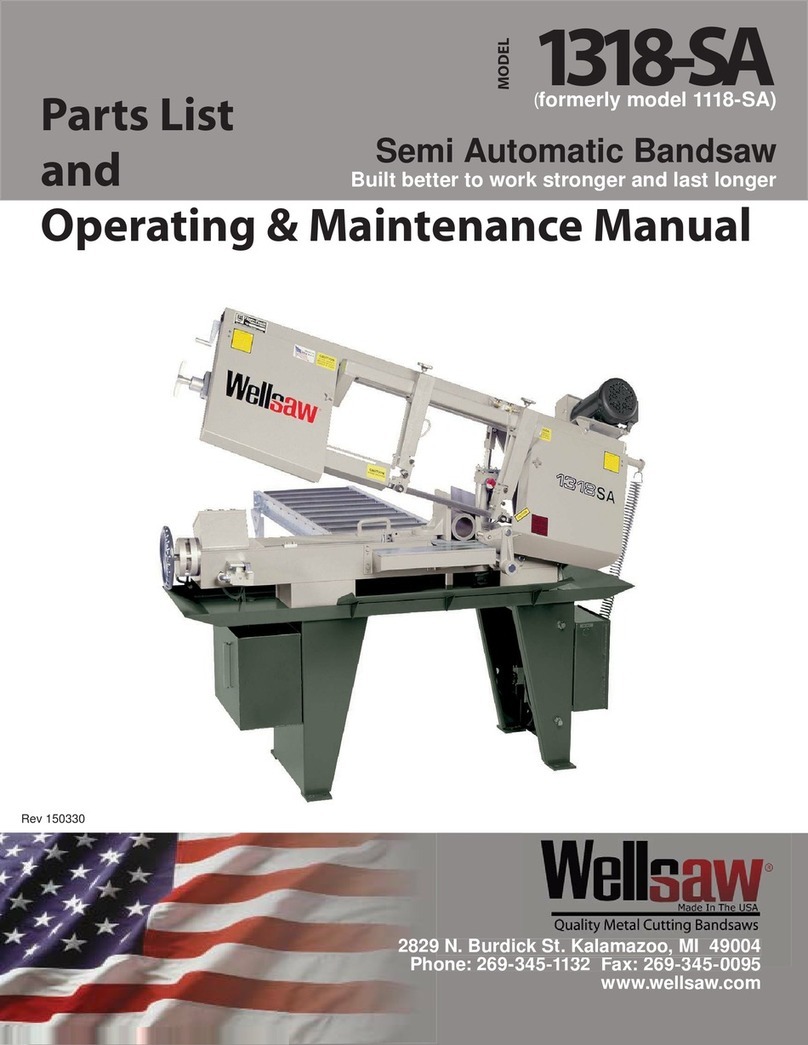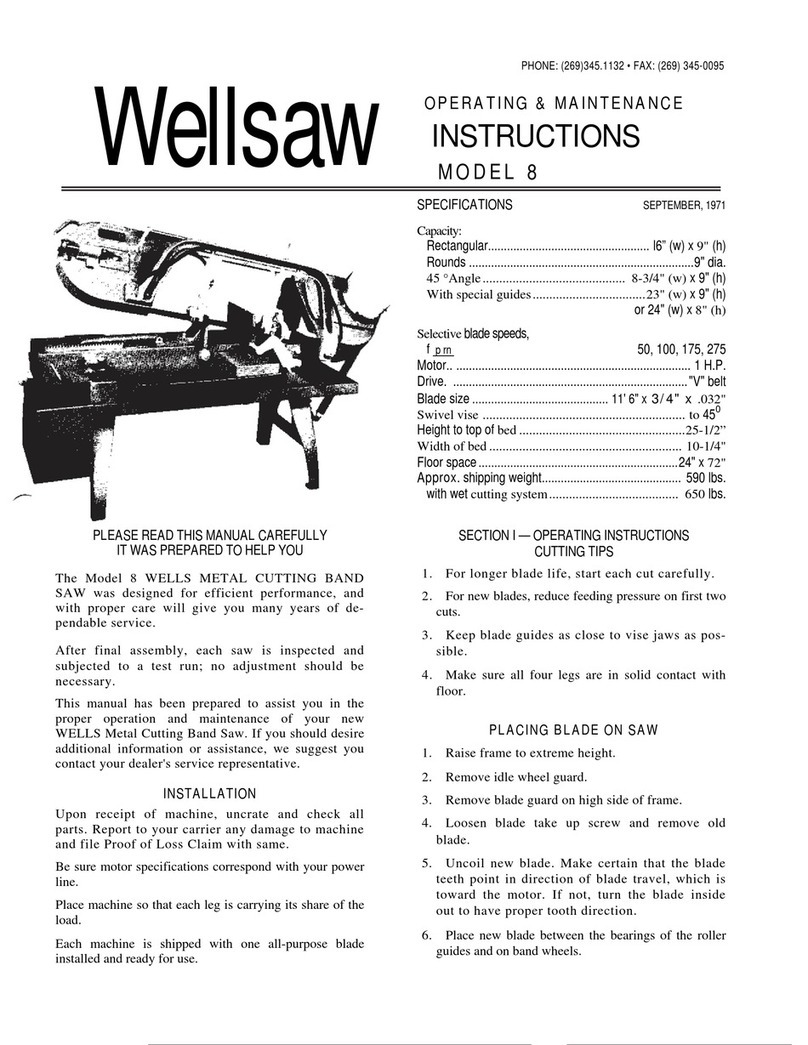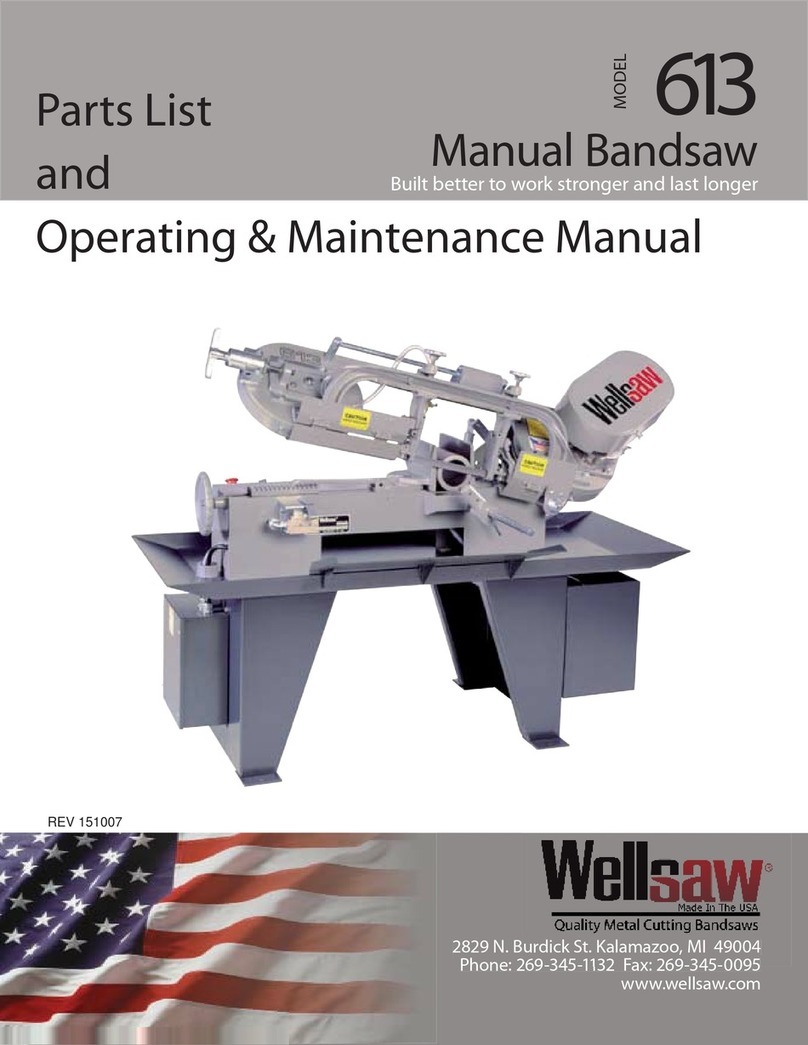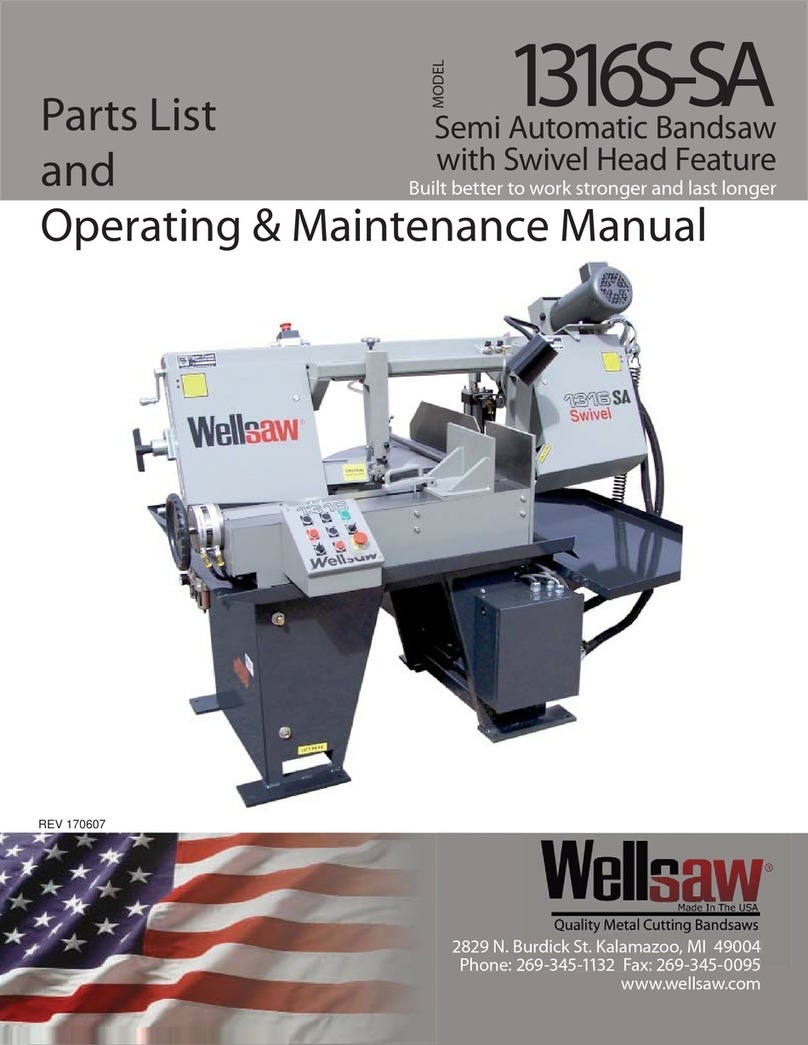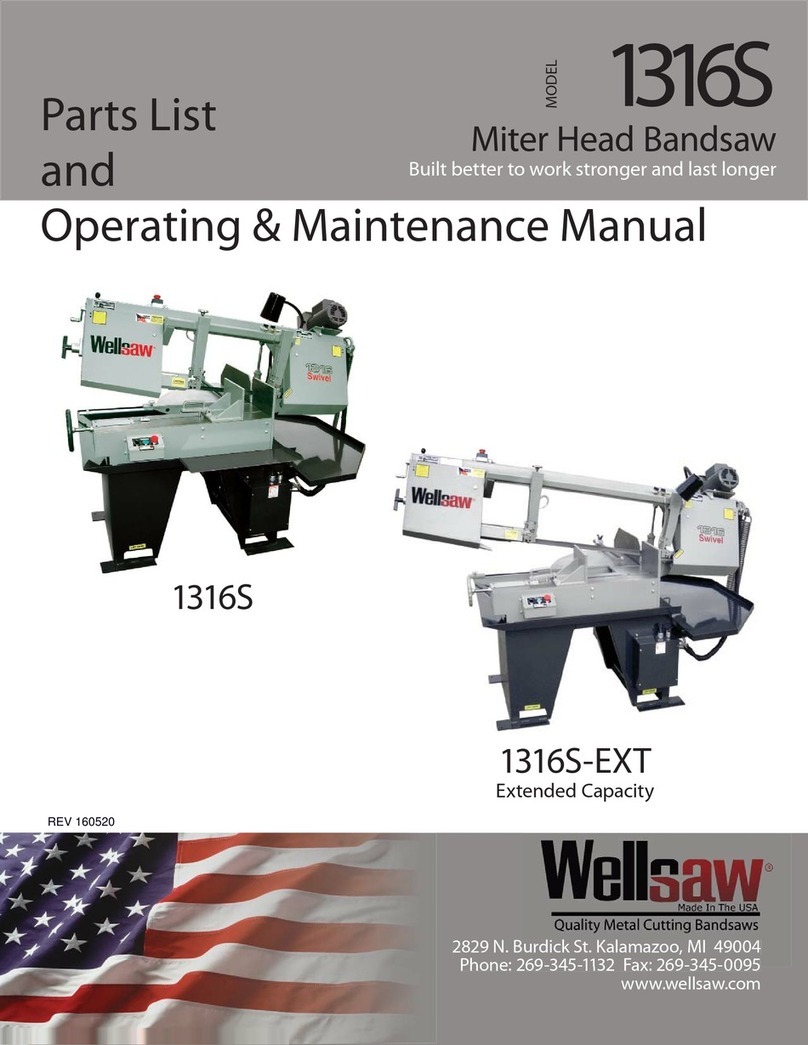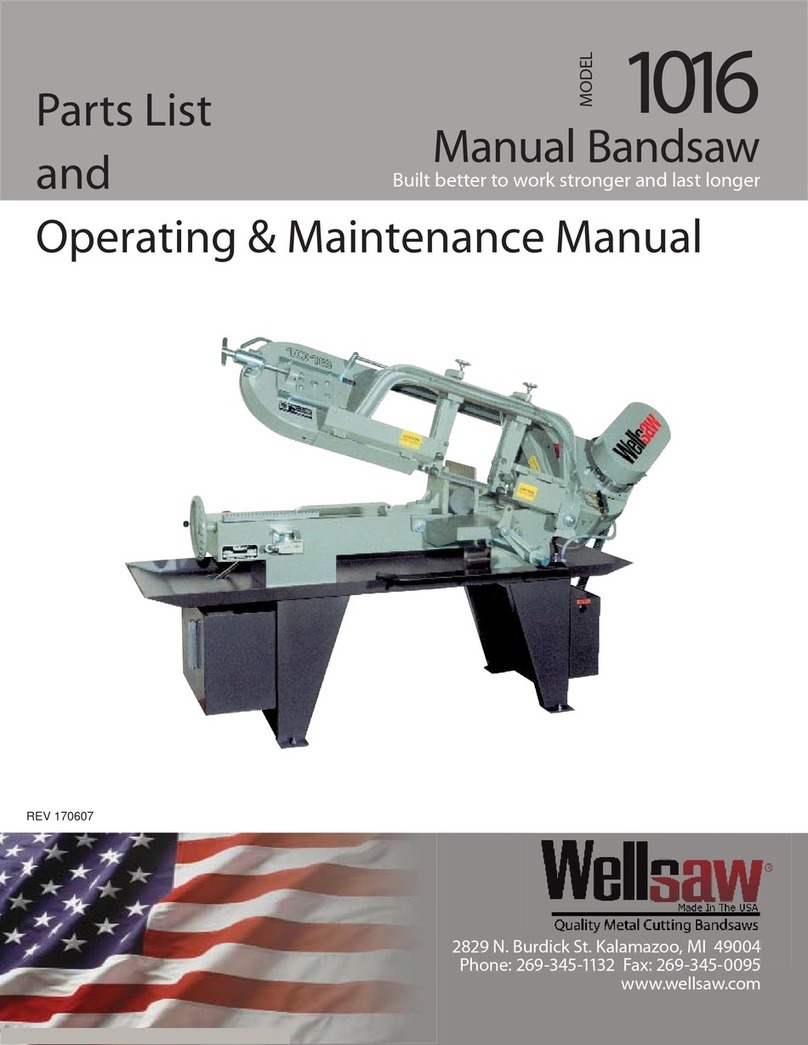
6
DASH POT
Wellsaws are equipped with a dash pot (frame
check) to stabilize the downward travel of the saw
frame to protect the saw blade from damage. The
action is hydraulic. The flow of fluid being bypassed
through an orifice controls the downward stroke of the
saw frame.
Fill the dash pot to within 1” of top of the bottom of
cylinder with Cities Service “Amplex 05” Hydraulic Oil
or equivalent.
FRAME WEIGHT ADJUSTMENT
The position of the collar in relation to the spring on
the dash pot acts as the frame weight adjustment.
The proper frame weight is approximately 10 lbs.
and is obtained by positioning the collar 3-3/4” down
from the top edge of the upper cylinder to the top edge
of the collar. For less frame weight, loosen collar and
move downward toward tension spring. Reverse pro-
cedure for more frame weight.
Too much frame weight will cause the blade to cut
crookedly.
SWITCH AND MOTOR
This saw is equipped with a start-stop switch that
automatically shuts off the motor at the completion of a
cut when the wheel guard contacts the switch control
lever to the desired position for proper shut-off.
It is necessary to raise the saw frame clear of the
switch control lever before the saw can be started.
Thermal overload protection is provided in the mo-
tor. Should the motor stop for other than normal rea-
sons, it may be due to overload. After the problem has
been corrected, the motor may be reset by following
the instructions on the motor name plate.
SPEED SELECTION
Saws are equipped with step pulleys that provide
three speeds: 76, 141 and 268 blade feet-per-minute.
Change blade speed by loosening wing screw close to
the motor pivot. Place belt in desired position, tighten
wing screw until belt is snug and lock wing screw with
wing nut.
FAST speed to cut thin-wall metal, tubing, thin
brass or any metal that will not burn teeth.
MEDIUM speed on general cutting such as cold
rolled machine steels or any metals which require a
slow speed on a lathe.
Use beeswax when cutting brass. Brass should
always be cut with a new blade. If teeth wear unusu-
ally fast, use slower speed. Always keep the blade in
proper tension.
MAINTENANCE
BEFORE MAKING ANY ADJUSTMENTS, ALWAYS
TRY A NEW BLADE TO MAKE SURE THE CAUSE
OF THE PROBLEM IS NOT A WORN BLADE.
Blade guides are provided to hold the blade in both
horizontal and vertical alignment.
Accuracy of cut depends on proper adjustment of
the blade bearings. Check their condition for wear or a
tendency to stick. When the blade is moved sideways
or with a twisting action, the movement should stop at
the bearings and not be transferred beyond this point.
An eccentric axle is provided on each blade guide.
By rotating this axle, the bearing is drawn away from
the blade.
WHEEL PITCH ADJUSTMENT
If the blade runs too low on wheels, it may be be-
cause of too much blade tension. Loosen the blade by
turning the “T” handle (10) counterclockwise (CCW).
The blade must be reasonably tight.
If this adjustment does not correct the problem, ad-
just the wheel pitch. Usually, adjusting the idler wheel
will correct the problem. However, if it doesn’t, both
idler and drive wheels will have to be adjusted as fol-
lows:
1. Loosen blade tension until the blade is slack by
turning the “T” handle CCW.
2. Raise the frame into the vertical position. See Dia-
gram.
3. Loosen 2 cap screws 7A and 7B 1/2 turn.. Then
tighten 2 cap screws 7C and 7D 1/2 turn.
4. Tighten blade by turning “T” handle CW. If the
blade then runs in proper position on both wheels,
no further adjustment is necessary.
If the blade runs back to the flange of the idler wheel
and not on the drive wheel, make the following adjust-
ment:
1. Loosen the 2 cap screws, 22E and 22F, at the mo-
tor end of the wheel plate.
2. Tighten the 2 Allen screws, 22G and 22H, about
1/2 turn.
3. Tighten all four cap screws.
4. Start the motor to see if the blade runs back to the
flange of the wheel.
CAUTION: Too much pitch will wear the wheel
flanges and roll over the back of the blade! This
problem can usually be determined by the noise of
the blade rubbing against the flange. To check fur-
ther, place a piece of paper between the blade and the
wheel. Start the saw. The blade should not shear the
paper but just fold it over. If it shears the paper, back
off the adjustment a little at a time until proper adjust-
ment is reached.
